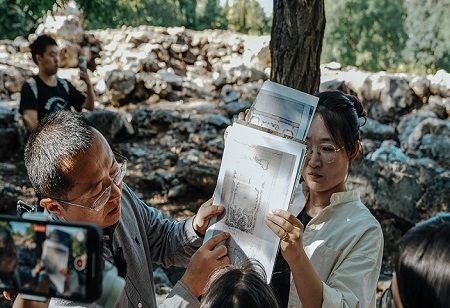The public open day at the Wenyuan Pavilion relic site in the Old Summer Palace (Yuanmingyuan) in Beijing welcomed over 20 students. This marked the first event following the release of new guidelines by China's National Cultural Heritage Administration aimed at improving archaeological research and education.
The guidelines highlighted the need for proper orientation and oversight regarding content and format, promoting immersive visits and hands-on learning experiences. They also urged provincial departments to compile lists of accessible archaeological sites, encouraging organized activities at parks, museums, research institutions, and active excavation sites.
Zhang Zhonghua, a deputy director of the Beijing Archaeological Research Institute (BARI), guided visitors through the discoveries made so far. He noted that their excavations have revealed the perimeter walls, cornerstones and remnants of the drainage system, and they have also uncovered traces of rivers and bridges that once connected the pavilion to the surrounding landscape. On the spot, Zhang also noted how the pavilion's distinctive architecture, including its palace gates and inner gardens, reflected the grandeur of imperial China.
"Our goal is to inspire more young people to develop an interest in archaeology. Understanding our past is essential to preserving our culture and history", Zhang said. "In the future, we would also like to let more citizens and tourists see what our Wenyuan Pavilion looks like and open this site to the public", Zhang added.
The Wenyuan Pavilion, originally built in 1775 during the Qianlong reign of the Qing Dynasty (1644-1911), was one of the grand libraries that housed the 'Siku Quanshu' or the 'Complete Library in the Four Branches of Literature', the largest collection of books in ancient China.
The pavilion was destroyed during the 1860 razing of Yuanmingyuan by Anglo-French allied forces, leaving only its ruins today. Experts report that archaeological work at this important site commenced in August 2024, with the current excavation spanning 1,000 square meters. During the event, participants learned about the site's wall structures and drainage systems, while also witnessing demonstrations of the tools and processes used in archaeology. Students were introduced to equipment such as measuring tapes, compasses, markers, and the Luoyang spade.
The Luoyang spade is an ancient Chinese tool used for detecting underground ruins. With a blade length of 20 to 40 centimeters and a diameter of 5 to 20 centimeters, it can penetrate several meters into the ground. By analyzing the soil it brings up, archaeologists can assess its composition and identify potential ancient tombs or underground features. Visitors, particularly students, were intrigued by how this tool is employed to study soil layers.
Since 2015, BARI has been advocating for public archaeology by opening excavation sites such as Yuanmingyuan to visitors. Live excavation demonstrations, expert-led tours, and interactive sessions have made archaeology more accessible to the public, enhancing appreciation for China's rich cultural heritage. As work at the Wenyuan Pavilion progresses, the site will remain open to the public until the end of October, giving more visitors the opportunity to observe the meticulous efforts of archaeologists and engage directly with China’s imperial history.

